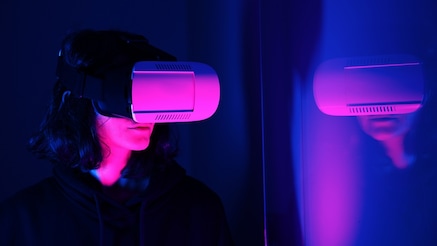Metaverse myth-busting challenge
Take the quiz
Metaverse myth-busting challenge
Can you separate fact from fiction?
From gamers in VR Goggles to a souped-up version of existing tech, the metaverse is either the future of the internet or a poor man’s Zoom. So, what’s it really about? Test your knowledge with our myth-busting quiz.
#1 The metaverse in 2022 is what the internet was to 1992
Back in 1992, many experts failed to understand how the world wide web would impact our world. Electronic mail, surfing, and retiring heavy-duty encyclopedias and CD-Roms were fanciful for many.
Similarly, building blocks are in place for the metaverse to develop and take off in various directions and promises to revolutionize everything. As with the internet back in the 90s, some applications will emerge, some will fail (remember MySpace or Virtual Boy?), and others will develop, while many haven't even been conceived.
In 2052, we'll likely make fun of some of the metaverse missteps we've yet to encounter, but as time has proven, we'll also bear witness to a world of endless possibility.
#2 The metaverse is a place in VR
The metaverse is not a place. It doesn't exist anywhere. The metaverse is about gradually blending our physical and digital worlds, most evident in fully immersive VR experiences but also in AR, XR (extended reality), or digital twins – which are commonplace in Industry 4.0.
VR allows you to hang out with friends from around the globe in an entirely digital world. AR/XR, meanwhile, brings the digital world to everyday physical surroundings.
So, while the evolution of VR headsets hastened the journey to the metaverse, it’s still only one part of the gradual merger of physical and digital reality.
#3 The metaverse is all about gaming
The metaverse goes far beyond gaming. While Roblox and Fortnite – the global platforms that bring people together through play – are part of many metaverse discussions, they’re just the tip of the iceberg. Yet the popularity of games – and the general move to gamification – may well herald the future of immersive entertainment.
However, the broader metaverse experience will include more than just gamification, such as industrial use cases, real estate investments, AR overlays on public transport and convenient shopping opportunities – where you can interact with goods virtually.
#4 The metaverse will clearly benefit industry
The industrial metaverse – transforming how physical assets are created, built, and operated – is a clear continuation of ongoing digital transformation.
Digital twins are already widely used in industry and beyond – so much so that the 3D digital image of a car is a familiar sight across adverts, brochures, and YouTube. Therefore, it’s merely a small step to move from existing digital replicas of reality – complete with the AI data crunching and edge computing necessary to make them work smoothly – into a new immersive industrial reality.
The benefits are clear: increased safety with remote management, continuous visibility, better training and collaboration opportunities, and more sustainable ways to achieve goals.
#5 The metaverse can be owned by one single company, person, or entity
The metaverse comprises a disparate collection of technologies, partnerships, and platforms. To deliver the metaverse experience, they'll need to work in harmony.
Collaboration and interworking are essential. So today, while several players are dominating the space, they are not necessarily the ones that will make it to the finish line. In the end, there will be platform, protocol, blockchain, device and application winners, but no ultimate owner of the metaverse.
#6 The metaverse is always decentralized
Today, a variety of metaverse implementation options are under development. Some take a centralized approach – when all elements are controlled and managed by a single entity, while others take a decentralized approach – when a broader community can develop and contribute to its evolution.
Newer web players favor a decentralized approach, but the race is still on, with different implementations evolving in parallel. Prominent examples of a decentralized approach are Decentraland and Sandbox, and for the centralized approach, there are Microsoft Mesh, Spatial.io or Meta Horizon.
#7 The metaverse is a critical part of Web 3.0
Web 3.0 is the next phase of the internet and is built on blockchain technology to allow users to create, own, and monetize their content. It will be sophisticated because it will present a truly interconnected new world based on interactions between software and software rather than just people and websites.
While the metaverse and Web 3.0 are similar in that they both use AI, the cloud, and connectivity, they are fundamentally different concepts that can evolve independently. The metaverse is essentially an internet experience, whereas Web 3.0 is an internet ideology for its next iteration.
#8 The metaverse will be the ultimate test for networks
Networks are tested constantly. The most extreme in recent times is the pandemic – which saw some networks experience a year of traffic growth in only a few weeks. Since then, the unpredictability of traffic patterns has come to be expected.
The next wave of technologies is unlikely to change this general trend, but with more of our work and leisure time spent in digital worlds, the metaverse will consume significant bandwidth.
With more capacity required to transmit data, better and faster networks will be needed to handle the metaverse traffic. While networks should – in theory – be able to meet that increase in demand, they need to keep up.
#9 The metaverse needs regulating
How do you regulate a space not yet created? While everyone agrees that regulation will need to start soon and must be able to flex to a wealth of future scenarios, customers, and business needs, identifying those challenges and risks is almost impossible.
Like any virtual space, real-world challenges – such as privacy, bullying, theft, money laundering, and business cartels – will arise and need to be tackled. However, just like in the early days of the internet, precisely what needs regulating and how is not yet clear. The good news is that this type of dialogue is already happening. So, in that sense, the journey to accommodate tomorrow has already begun.











